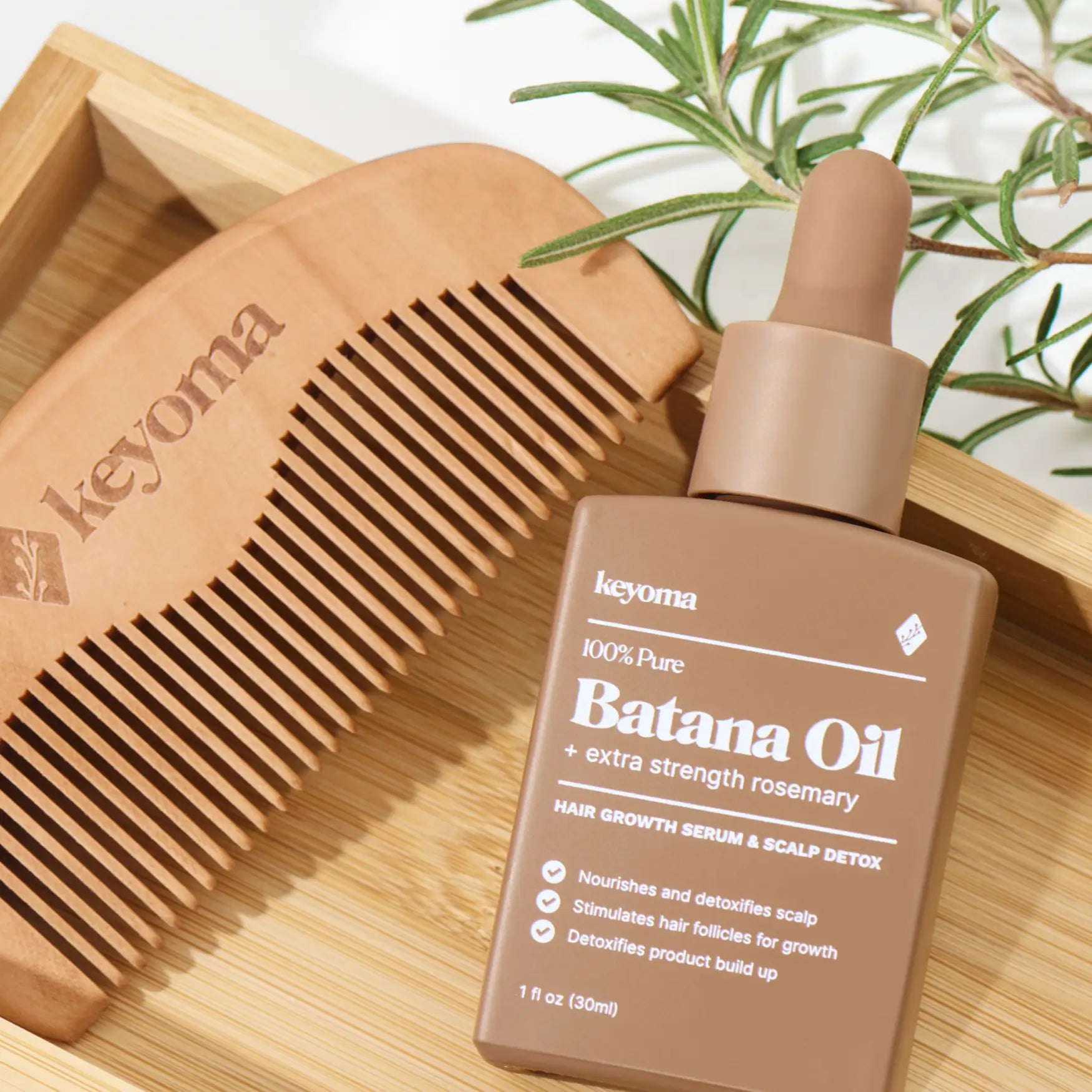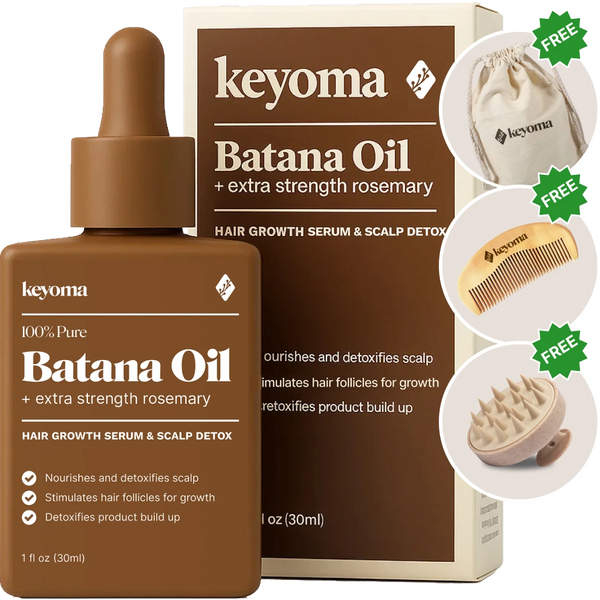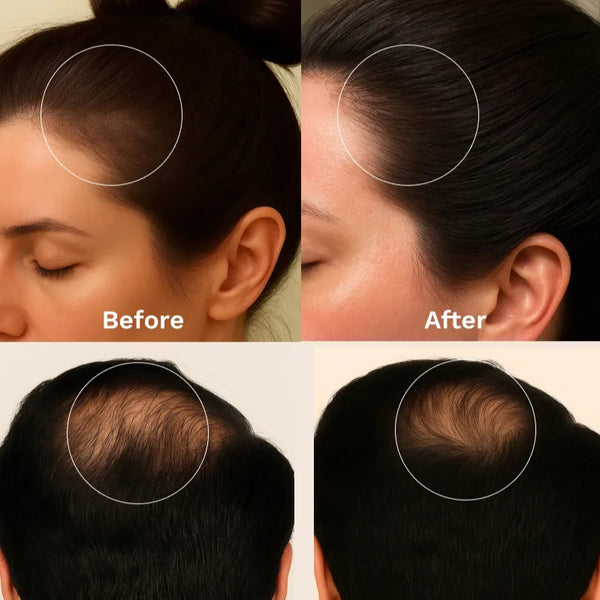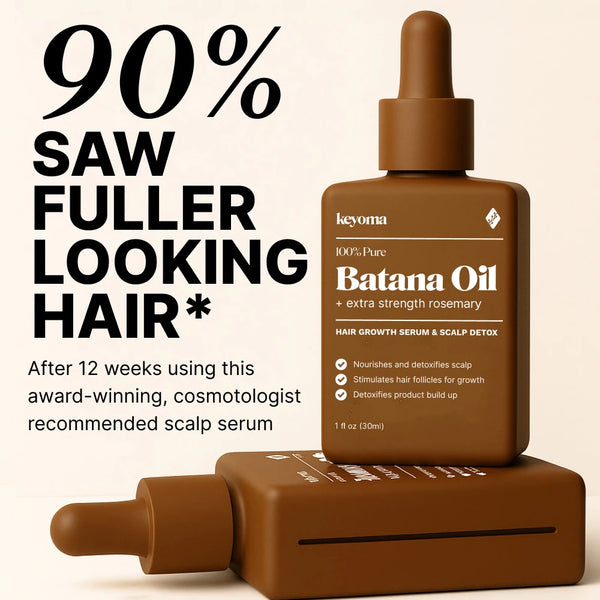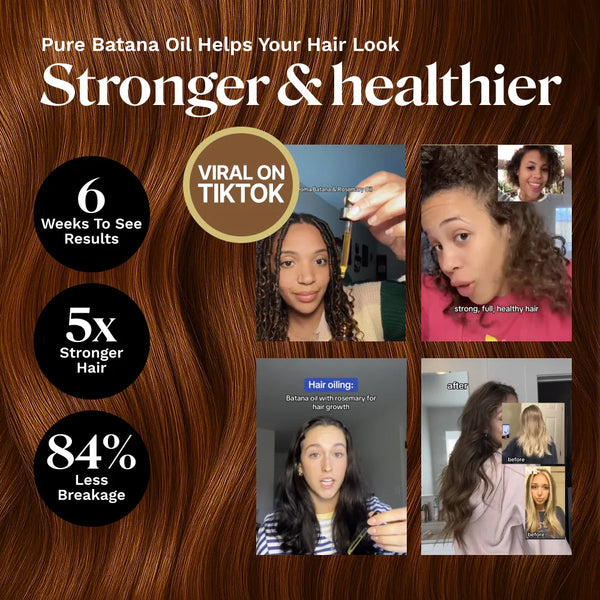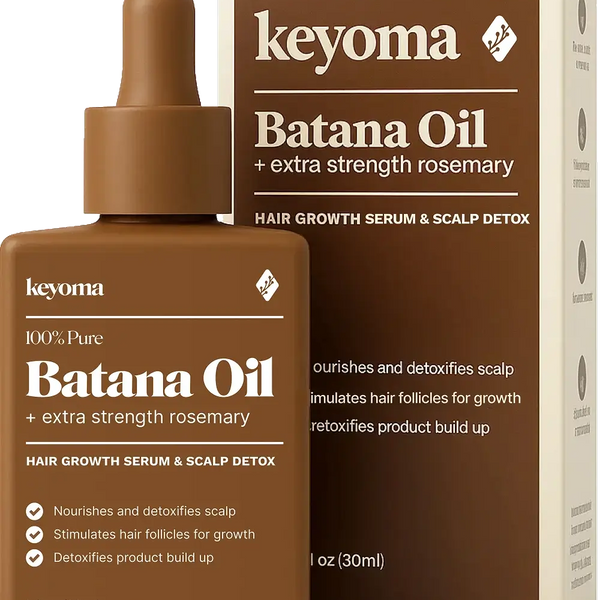In this article
Bee venom in hair serums might sound a bit intense, but the truth is it’s generally safe. When used in low concentrations, it can actually do wonders for scalp health and hair growth, and that's according to research.
Still, like any beauty product (even the “all-natural” ones we swear by), there’s always a small chance your skin might react differently. Allergies, sensitivities, or simple irritation can happen, especially if your scalp leans reactive or if you’re trying bee-based ingredients for the first time.
In this article, we’ll talk through the possible side effects of bee venom hair serums, how to spot them early, and what to do if they show up so you can enjoy all the hair-loving benefits without the worry.
Key Takeaways
-
Bee venom serums can support scalp health but may cause mild redness or tingling.
-
People with bee allergies or sensitive skin should consult a doctor before use.
-
Always patch-test first to prevent irritation or unexpected allergic reactions.
What Is Bee Venom in Hair Products?
Bee venom in hair products refers to a purified natural secretion from honeybees, used in very tiny amounts—usually between 0.01% and 1%—which studies show are generally safe for topical use.
Now, it’s not something added just to sound fancy on the label. Nor is it another fleeting hair-care trend. Formulators use bee venom because modern research links it to scalp health and even potential hair-growth support.
Scientifically speaking, bee venom is a fascinating mix of peptides, enzymes, and amino acids. Its main compound, melittin, has anti-inflammatory and microcirculatory effects that help calm the scalp while promoting nutrient delivery to the follicles.
It first caught major attention in Korean dermatology labs, where researchers observed improved hair density when diluted bee venom was applied under controlled conditions.
And yes, in case you’re wondering—it’s collected humanely. A thin glass or mesh plate gently encourages the bees to release venom without harming them. The dried secretion is then purified, measured, and blended into serums or creams.
Common, Mild Side Effects of Bee Venom Serum
While bee venom hair serums are generally considered safe, even natural ingredients can cause minor reactions. These effects usually fade within hours and don’t indicate danger or product failure—they’re simply your scalp adjusting.
Below are the most common mild side effects and what’s happening behind each one.
Tingling or Warmth
A brief tingling or gentle warmth often appears within minutes of applying bee venom serum. It may feel like a mild flush, as though your scalp is "waking up".
On that note, many people mistake this for a “sign of growth,” but it isn’t. What’s actually happening is that melittin, the active peptide in bee venom, is stimulating tiny blood vessels and improving circulation near the surface of your skin.
This sensation should fade quickly. If it lingers or burns, rinse the serum off and try again with a smaller amount.
Temporary Redness or Scalp Sensitivity
Some people notice their scalp looking pink or feeling a bit tender after the first few uses. It’s similar to mild post‑exfoliation sensitivity, often noticeable but short‑lived.
Bee venom can temporarily increase local blood flow, which gives that flushed look. The redness usually fades within an hour or two as the skin rebalances.
Avoid applying on freshly exfoliated or irritated areas to minimize this reaction.
Itchiness or Dryness
A light, intermittent itch may develop, especially if your scalp barrier is already dry.
The peptides in bee venom can slightly alter your skin’s lipid balance while it adjusts to the product. This can lead to temporary dryness or tightness.
To help, pair your serum routine with a hydrating scalp mist or a few drops of a lightweight oil like jojoba to restore comfort.
Fragrance‑Related Irritation
Synthetic or even natural fragrance compounds can sometimes activate sensitive nerve endings in the scalp. So if your bee venom serum is fragranced, that mild irritation you feel might come from the added scent rather than the venom itself.
It often shows up as a faint itch or prickling along the hairline or behind the ears shortly after application.
That’s why I always recommend choosing a fragrance-free or essential-oil-free version instead.
Less Common But Concerning Reactions
Most people tolerate bee venom serums well, but there are rare cases where the skin reacts more intensely. These usually occur only in people with:
-
an existing bee allergy;
-
highly sensitive immune systems; or
-
damaged scalp barriers.
Even so, it’s important to know what to watch out for and how to recognize when a simple irritation has crossed into something more serious.
Contact Dermatitis (Allergic Skin Reaction)
When your immune system mistakes bee venom as a threat and overreacts, an allergic skin reaction—called contact dermatitis—can occur. You might notice small, red, itchy bumps that sting slightly when scratched, similar to a mild poison ivy rash.
This happens because your skin’s immune cells release histamines in response to compounds like melittin and apamin. The reaction can appear within a few hours of applying the serum or even the next day.
Applying ice, gently washing the product off, and using a soothing barrier cream usually help calm things down. But if the irritation keeps coming back, it’s best to stop using the product altogether.
Hives, Swelling, or Wheezing
These reactions are more visible—and understandably, more alarming. Hives appear as raised, red welts that itch intensely and can merge into larger patches. They may show up on your scalp, neck, or even around your eyes.
Swelling around the eyelids or lips can follow, and in rare cases, you might experience chest tightness or wheezing.
This happens because your body is having a systemic allergic response, releasing histamines not just in the skin but throughout the body.
It’s rare, especially since bee venom concentrations in hair serums are extremely low. But if it does happen, rinse your scalp right away, take an oral antihistamine if recommended by your doctor, and seek medical attention as soon as possible.
Anaphylaxis
Anaphylaxis is extremely rare, but it’s life-threatening. It’s the body’s most severe allergic response, and it can begin within minutes of exposure.
You’ll know it’s not ordinary irritation when symptoms include difficulty breathing, swelling of the tongue or throat, dizziness, or a sudden drop in blood pressure.
Unlike redness or tingling that stays on the surface, anaphylaxis involves your entire immune system reacting all at once. Call for medical help right away and use an epinephrine injector if you have one prescribed.
Should I Avoid Bee Venom Hair Serums?
If you fall into any of the following groups, you’ll want to be extra cautious before trying bee venom products:
-
Known bee or wasp sting allergies
-
Asthma or mast cell disorders
-
Broken or compromised scalp skin
-
Pregnant or breastfeeding
-
Taking medications or managing conditions that may interact
It’s a no-brainer move to avoid bee venom serums entirely if any of these apply to you. However, I personally wouldn’t write it off completely.
With its potential benefits for scalp health and hair growth, the smartest thing you can do is talk to your doctor or dermatologist first. They’ll help you figure out if it’s safe or if another gentler alternative might suit you better.
How to Patch-Test Bee Venom Hair Serum Safely (Step‑by‑Step)
A patch test is the easiest way to make sure your skin gets along with the product before you use it all over. Follow these steps to test safely and avoid the usual slip-ups.
1. Choose the right test area.
Pick a small spot behind your ear or on the inner side of your arm—places where the skin is thinner and more sensitive, similar to your scalp. Avoid testing on already irritated or freshly washed skin since that can exaggerate the reaction.
2. Apply a pea‑sized amount.
Use a clean fingertip or cotton swab to dab a tiny amount of the bee venom serum onto the chosen area. You don’t need much. Overapplying can trigger unnecessary irritation.
3. Let it sit for 24 hours.
Leave the area untouched and uncovered. During this period, note if you feel mild tingling, warmth, or itching. Those sensations can be normal, but burning, swelling, or intense redness means your skin is reacting negatively.
4. Rinse and observe.
After 24 hours, wash the area gently with lukewarm water and mild cleanser. Wait another few hours to see if delayed irritation develops (because some allergic reactions appear later rather than immediately).
5. Decide whether to proceed.
If the patch stays calm with no rash, swelling, or pain, you’re likely fine to use the serum on your scalp. But if anything feels off, it’s safer to skip or consult a dermatologist before trying again.
What to Look For in a Bee Venom Serum Label
Even the cleanest formulas can cause irritation if you’re not paying attention to what’s on the label. Here’s what you’ll want to check before buying:
-
Look for Bee Venom or Melittin listed clearly in the ingredients. Don’t confuse this with Honey Extract or Propolis, which are different bee by‑products and don’t carry the same effects or risks.
-
Concentration Disclosure. Most reputable brands use less than 1% bee venom. Anything higher should raise a red flag since higher doses increase the chance of irritation or sensitivity.
-
Soothing or Balancing Ingredients. Aloe, panthenol, niacinamide, or allantoin can help offset the sting effect and reduce redness. Their presence is a sign of thoughtful formulation.
-
Avoid Fragrance. Fragrance might make the serum smell nice, but it’s also one of the most common triggers for scalp irritation. Pick a fragrance‑free version as much as possible.
-
pH Range. A balanced pH (around 4.5 to 5.5) keeps your scalp barrier intact. Products too acidic or too alkaline can worsen dryness or redness.
-
Patch Test Reminder on Label. Responsible brands often mention this directly. It’s a subtle but telling sign that they understand their ingredient’s potency.
Frequently Asked Questions (FAQs)
Can bee venom cause hair growth or loss?
Bee venom, when used properly and in low concentrations, has been shown in several studies to support hair growth. It works by improving blood circulation in the scalp and activating growth factors within the follicle cells.
That said, if you’re allergic or apply it to an already irritated scalp, inflammation or excessive scratching can lead to temporary shedding.
Can I use bee venom hair serum with minoxidil?
It’s possible, but it's recommended to seek medical advice, especially with regards to frequency and specific instructions for topical application.
Both bee venom and minoxidil increase scalp blood flow and can trigger mild irritation on their own, and layering them may amplify the side effects.
How often can I use bee venom serum?
You can use bee venom serum every day, just like many other scalp serums. To play it safe, start by applying it two to three times a week, then work your way up once your scalp adjusts and shows no signs of irritation.
Just keep in mind that overusing won’t speed up results. In fact, it can do the opposite, increasing sensitivity or causing mild flare-ups instead.
What are hair product alternatives to bee venom?
If you’re sensitive to bee products but still want a serum that supports regrowth, go for ingredients that target circulation and follicle health without triggering allergies. Great options include rosemary oil, niacinamide, peptides, caffeine, and ectoin.
Start Your Bee Venom Journey
Wrapping up, bee venom hair serum is generally safe, especially when introduced gradually into your routine. Most of the so-called side effects are mild—a bit of redness or a short-lived tingle—and nothing that lasts or lingers.
And I can vouch for that. I’ve been using a bee venom hair serum almost every day, and it’s never given me a reason to worry. If anything, I’m convinced it’s helped those baby hairs keep showing up along my hairline.
Give it a try, but always remember to patch test first. And if you want more tips, routines, and ingredient breakdowns that actually work (and 100% free!), head over to the Keyoma blog!
Featured Product
100% Pure Batana Oil + Rosemary
↓Best Batana Oil to Buy↓
1 Month
Subscribe & Save
- 30-day supply delivered monthly $35
- 30% off for life $6
- Free haircare essentials kit $33
- Free custom wooden comb $10
- Free scalp massager $15
- Free eco-friendly travel bag $8
- 30-Day Money Back Guarantee
- Free Shipping
- Online portal for easy cancel, skip, or pause.
1 Month One Time Purchase
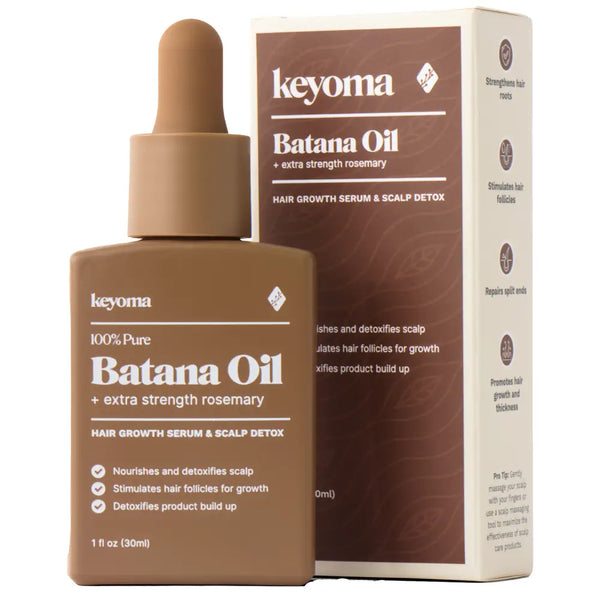
- 30-day supply $50
- 30% off for life $6
- Free haircare essentials kit $33
- Free custom wooden comb $10
- Free scalp massager $15
- Free eco-friendly travel bag $8
Your Cart
Your Cart is empty
Let's fix that
You might like...
Search our store


